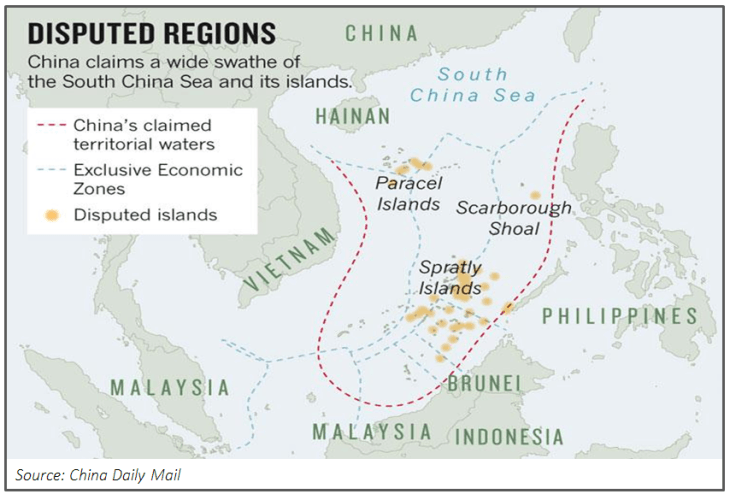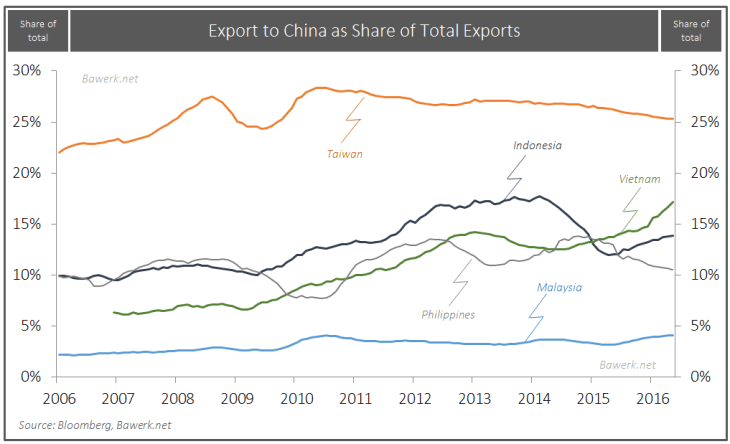With global attention focused on BREXIT calamity, potentially more important questions are being overlooked, and especially in the South China Sea where storms are currently brewing between China and a range of littoral states for strategic control of territorial waters. To be clear, our long term geostrategic position remains unchanged; China moving towards the ‘nine dash’ line China will gradually secure control of the South China and East China Seas through its so called ‘nine dash’ line, with the eventual battle for geo-maritime ascendency playing out in the Indian Ocean into the 2030s between China on the one hand, and America on the other. That much remains inexorable, but it’s what happens along the way to that eventual outcome where all the residual risks remains. The Chinese consolidation of its nine dash line Anyone willing to stand in the way of Chinese geopolitical pull, will be pushed off the edge of a ‘geo-economic atoll’, at least when it comes to creeping Chinese consolidation of its nine dash line.
Topics:
Eugen von Böhm Bawerk considers the following as important: Bawerk, China, emerging markets, Featured, Geopolitics, newsletter, Shinzo Abe, US
This could be interesting, too:
Nachrichten Ticker - www.finanzen.ch writes Die Performance der Kryptowährungen in KW 9: Das hat sich bei Bitcoin, Ether & Co. getan
Nachrichten Ticker - www.finanzen.ch writes Wer verbirgt sich hinter der Ethereum-Technologie?
Martin Hartmann writes Eine Analyse nach den Lehren von Milton Friedman
Marc Chandler writes March 2025 Monthly
With global attention focused on BREXIT calamity, potentially more important questions are being overlooked, and especially in the South China Sea where storms are currently brewing between China and a range of littoral states for strategic control of territorial waters. To be clear, our long term geostrategic position remains unchanged;
China moving towards the ‘nine dash’ lineChina will gradually secure control of the South China and East China Seas through its so called ‘nine dash’ line, with the eventual battle for geo-maritime ascendency playing out in the Indian Ocean into the 2030s between China on the one hand, and America on the other. That much remains inexorable, but it’s what happens along the way to that eventual outcome where all the residual risks remains. The Chinese consolidation of its nine dash lineAnyone willing to stand in the way of Chinese geopolitical pull, will be pushed off the edge of a ‘geo-economic atoll’, at least when it comes to creeping Chinese consolidation of its nine dash line. Right on cue, the Chinese have just leant heavily on Cambodia to retreat a joint ASEAN statement against Beijing’ claims in the South China Sea, as a classic Chinese tactic to keep any disputes purely on a bilateral divide and rule basis with Vietnam, Indonesia, Philippines, and to a lesser extent, Malaysia. Coincidently, this is where China has all the economic leverage (see chart). That will take some of the heat off the pending ASEAN Regional Forum, not to mention Chinese G20 meetings in September. But the overall rules of the game are clear: If or when, China faces any geopolitical opposition to its maritime claims, it won’t hesitate to wield a large geo-economic stick to beat smaller starts into submission. Needless to say, exactly the same story applies closer to North East Asian home when it comes to maritime tussles with Japan over the Senkakus, and South Korea over Takeshema. China will continue to divide and rule competing littoral states, using geo-economic strength to rail through new geo-maritime facts on the ground. |
The Spratly IslandsThe most proximate trigger currently relates to pending legal rulings in The Hague that’s almost certain to rule in favour of Philippines legal claims towards the Spratly Islands. We’ll leave all the legal complexities aside, where this is essentially adjudicating on the technical basis of UNCLOS claims rather sovereignty per se. But suffice to say, China will not only reject the findings, it will up the ante with sabre rattling and maritime movements around the Spratly’s with further land reclamation around Scarborough Shoal. It’s also possible China will initiative targeted sanctions against Manila (a nice welcome message for the incoming President Duterte) to prove its point. |
Will the US put a serious finger in China’s ‘nine dash’ dyke?The real question isn’t whether Japan, South Korea, Vietnam, Philippines, Indonesia or Malaysia occasionally play up and push back against Chinese actions, but ultimately where the US is going to draw the line to put a serious finger in China’s ‘nine dash’ dyke? While it’s true America is overseeing a fundamental reboot of the 7th fleet, shifting 60% of its naval and maritime assets to Asia by 2020 with far more ‘tit for tat’ maritime measures being taken against Chinese when it comes to patrols, carrier movements and coast guard co-operation. It also comes with an added push from the Obama Administration to get a last minute Trans Pacific Partnership deal through to give America some kind of viable retort to AIIB onslaughts from China. But at the end of the day, as much as Washington wants to be credible in Asia, it doesn’t want to be credible at any price, and especially not over a bunch of rocks and islands that are high symbolism, but very low on genuine strategic worth. Will Abe drag America into a conflict with ChinaWhile it’s possible Shinzo Abe will drag America to the brink of conflict with China before his LDP term is up in 2019, when the time comes, not only will America stand down in North East Asia and ASEAN, it’s going to consume most of its political capital trying to get its supposed Asian allies to play nice together rather than drawing a serious line against Chinese naval expansion. Only the US-China G2 nexus mattersAt the end of the day, the only geopolitical relationship that globally matters over the next decade is the US-China G2 nexus, with all the geo-strategic, geo-maritime, and ultimately geo-economic (currency) complexity that brings. For us, that’s precisely why the US is going to put on a ‘brave face’ in North East Asia and ASEAN containment, but ultimately cuts its losses and concede to Beijing’s local dominance. Yet by precisely the same token, it’s also why the long term battle lines for maritime supremacy will ultimately be drawn in the Indian Ocean between the US and China towards 2030. Seen like that, the South China Sea is important, but it’s ultimately a storm in a far larger Indian Ocean teacup… |


